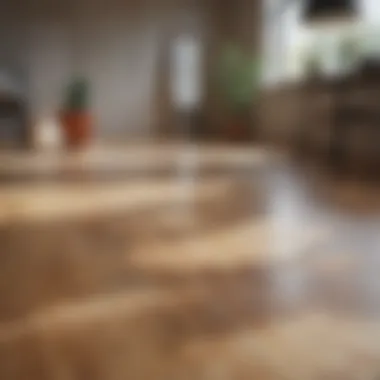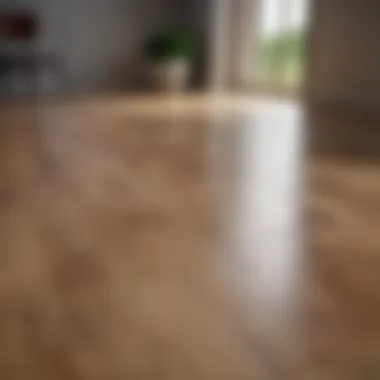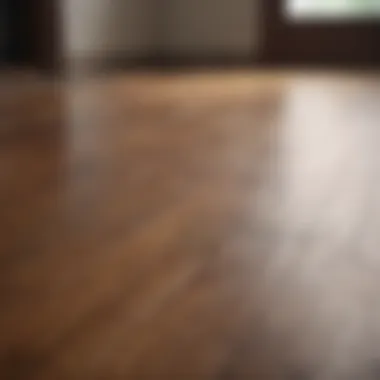Safe Cleaning Solutions for Laminate Flooring


Intro
Laminate flooring has gained significant popularity in homes, offering a perfect balance of style and durability. However, maintaining its shine and integrity requires a careful choice of cleaning products. Homeowners often find themselves in a conundrum—choosing between effective cleaning solutions and safe options that are kind to both their floors and the environment. This necessity for balance drives the need for a comprehensive understanding of safe cleaning products that can help preserve the aesthetic value of laminate flooring.
Choosing the right cleaning agent is more than surface-level; it’s a decision influenced by health, safety, and environmental factors. As laminate surfaces are often susceptible to damage from harsh chemicals, finding eco-friendly solutions becomes paramount.
This article aims to explore the different cleaning products available, their effects on laminate floors, and how to maintain that gleaming appearance without compromising safety.
"Cleaning products can be as harmful as they are helpful; knowing what to use is just as essential as knowing how to use it."
By delving into the nuances of material selection and effective cleaning techniques, this guide sets the stage for homeowners eager to learn about suitable products for their beloved laminate floors. Let’s embark on this enlightening journey and unveil the sensible cleaning choices that will keep your home in tip-top shape.
Understanding Laminate Flooring
When it comes to taking care of your home, understanding laminate flooring is crucial. For many homeowners, laminate is an appealing floor choice due to its affordability, versatility, and the aesthetic charm it can bring to any space. However, to maintain its look and integrity, knowing how laminate is constructed and what it requires for optimal maintenance is essential.
Composition of Laminate Flooring
Laminate flooring is typically made up of four main layers: the backing layer, the core layer, the design layer, and the wear layer. The backing layer provides stability and moisture resistance, while the core layer, usually made from high-density fiberboard, offers durability and support. The design layer gives laminate its appearance, mimicking the look of wood or stone at a fraction of the cost. Finally, the wear layer acts as a protective barrier against scratches and stains, ensuring that the flooring remains looking fresh for years to come.
This multi-layered structure makes laminate both practical and appealing; however, it’s also sensitive to certain cleaning agents that can damage it.
Advantages of Laminate Flooring
There are several advantages to laminate flooring that make it an attractive option for various types of homes:
- Cost-Effective: Compared to hardwood or stone, laminate is generally much cheaper, making it accessible for many budgets.
- Easy Installation: Most laminate flooring features a click-and-lock design, allowing for straightforward installation without the need for professional help.
- Variety of Styles: Available in a wide range of styles, colors, and finishes, laminate can suit any design aesthetic.
- Durability: With proper care, laminate can withstand heavy foot traffic, making it suitable for busy areas in the home.
While these advantages are significant, they can quickly diminish if proper cleaning techniques and products are not used.
Common Misconceptions about Laminate Flooring Care
Many believe laminate flooring is impervious to damage, but this is simply not the case. One common misconception is that laminate can handle an excessive amount of water. In reality, water damage can warp and ruin the flooring if moisture penetrates the seams. Another myth is that any cleaning product, even harsh chemicals, can be used. Using the wrong cleaners can strip the protective layer, leaving the floor vulnerable.
Moreover, there’s a pervasive notion that laminate requires no maintenance. While laminate is low-maintenance compared to other flooring types, it still needs regular cleaning to retain its appearance and functionality.
In summary, by understanding laminate flooring’s makeup and the misconceptions surrounding its care, homeowners can make informed choices, particularly when selecting safe cleaning products. This knowledge is not just beneficial for maintaining visual appeal; it also preserves the longevity and performance of the flooring.
The Need for Safe Cleaning Products
Laminate flooring adds a touch of elegance to many homes, but keeping it clean requires careful consideration of the products you use. The importance of selecting safe cleaning products cannot be overstated. Not only do these products maintain the aesthetic and longevity of your floors, but they also protect your home’s atmosphere and health.
In recent years, awareness of the harmful effects of certain cleaning solutions has grown significantly. Many common cleaners contain toxic chemicals that can contribute to indoor air pollution and pose health risks. For homeowners, recognizing these risks is the first step towards creating a healthier living environment.
Health Risks of Toxic Cleaning Agents
Many store-bought cleaning products contain harsh chemicals that can be detrimental to both health and the environment. Substances like ammonia and chlorine bleach are not uncommon; these might seem effective at killing germs, but their respiratory irritations can lead to headaches, throat irritation, and, in severe cases, chronic health issues.
For instance, a mild cleaning agent might seem harmless, but repeated exposure could lead to unexpected respiratory difficulties. Households with pre-existing vulnerabilities, such as small children or individuals with allergies, need to be particularly cautious. Moreover, prolonged exposure to toxic substances might not only affect immediate health, but also trigger more serious long-term conditions. A clear understanding of the risks associated with these cleaners underpins the need for safer alternatives.
Environmental Impact of Conventional Cleaners
The broader implications of cleaning products extend beyond individual health; they also have a significant impact on the environment. Conventional cleaners often contain substances that do not break down easily, leading to pollution of waterways and soil.
Many synthetic ingredients in cleaners can be harmful to aquatic life and ecosystems. Run-off from our homes contributes to this problem, and even disposable containers of these products can take hundreds of years to decompose. By opting for more eco-friendly solutions, we not only protect our homes from chemical exposure but also contribute positively to the environmental landscape. Making informed decisions about your cleaning supplies is therefore an essential part of a more sustainable lifestyle.
Safety Concerns for Children and Pets
In households with young children or pets, the stakes are even higher. Children, in their natural curiosity, may come in contact with cleaning agents—sometimes ingesting them without a second thought. Pets, too, can be unwittingly exposed to toxic residues left on floors after cleaning. Both scenarios can lead to dangerous health outcomes, from mild gastrointestinal distress to more serious poisoning incidents.
Thus, safety must be a priority when choosing cleaning products. Non-toxic and natural cleaning solutions provide peace of mind, ensuring that your living spaces are safe for every member of your family—two-legged or four. Furthermore, creating a safer home environment fosters responsibility and awareness among children as they learn early about the importance of choosing safe alternatives.


"The shift to safer cleaning products isn’t merely a trend; it’s a necessary step towards healthier homes and a sustainable future."
Types of Safe Cleaning Products
Natural Cleaning Solutions
Vinegar and Water Mixture
A simple yet effective cleaning concoction, the vinegar and water mixture stands out due to its ability to cut through grime without leaving harmful residues. Vinegar is mildly acidic, which helps to dissolve mineral deposits and other stains, making it quite useful on laminate surfaces. Homeowners appreciate it for its affordability and ease of access, as most have vinegar in their kitchen.
However, one must use this mixture sparingly, as overuse can lead to dullness over time. It’s a bit of a balancing act; too much vinegar can affect the laminate finish.
Baking Soda Paste
Baking soda is another household staple that works wonders in tackling tougher stains or scuff marks that just won't budge. When combined with a bit of water to form a paste, it becomes a gentle abrasive. This non-toxic solution is particularly appealing for those who worry about harsh chemicals harming their loved ones or their pets.
When using baking soda paste, it’s crucial not to scrub too vigorously, as it might scratch the laminate. Its uniqueness lies in its versatility; it can also be used on various surfaces, from kitchen counters to sinks, making it a favorite for many.
Essential Oils for Freshness
To infuse a delightful scent while cleaning, essential oils are a wonderful addition. A few drops mixed with either vinegar or a carrier solution can transform a mundane cleaning task into a fragrant experience. Popular options like lavender or lemon not only make the space smell fresh but also possess certain antibacterial properties.
Though beneficial, one should ensure that the oils chosen are safe for laminate surfaces, as some oils can be overly oily and might leave a residue.
Commercial Eco-Friendly Cleaners
Plant-Based Formulations
The growing concern for sustainability has led to an increase in plant-based cleaning products. These formulations harness the cleaning power of natural ingredients, avoiding aggressive chemicals that can harm both the flooring and one’s health. Many people gravitate towards these products due to their effectiveness and a sense of environmental responsibility.
These options usually come with clear labeling, making it easier to identify their benefits. However, one should do thorough research, as not all plant-based cleaners are equally effective on tough stains.
Biodegradable Products
Biodegradable cleaning products decompose naturally, leaving no harmful residues behind in landfills or waterways. This choice appeals to environmentally conscious consumers who want to lessen their ecological footprint. These products not only provide a cleaner home but also a cleaner planet.
Nevertheless, users might find these products to be pricier than traditional cleaners, which can be a concern for budget-conscious households.
Non-Toxic Certifications
When it comes to safety, non-toxic certifications can be a golden standard for choosing cleaners. Such certifications ensure that the products you’re using are free from harmful chemicals that could pose risks to health.
Going for certified items adds a layer of assurance. However, some certifications can be misleading, so it’s prudent to research the certifying body’s standards before purchase.
DIY Cleaning Solutions
Creating Your Own Solutions
For the crafty among us, creating your own cleaning solutions can be an excellent way to customize your cleaning routine. By understanding which ingredients work best, you can tailor recipes to suit your specific needs, be it tackling tough stains or simply maintaining the shine of your floors. This DIY approach is also a great way to reduce packaging waste, appealing to eco-conscious consumers.
One potential downside is the time-investment needed for formulation and testing, especially when figuring out what works best for your flooring.
Benefits of Homemade Cleaners
Homemade cleaners often come with a host of benefits, from customization to cost-effectiveness. With basic ingredients like vinegar, baking soda, and essential oils, you can whip up effective cleaning solutions that won’t break the bank. Additionally, knowing exactly what goes into your cleaner means you’re less likely to encounter harsh chemicals.
However, the effectiveness of these cleaners can vary, and sometimes, a little trial and error is necessary to get the best results.
Cost-Effectiveness of DIY Cleaning Products
Cost is a significant factor for many when choosing cleaning products. DIY cleaning solutions can save money in the long run. Instead of purchasing specialized cleaners for various tasks, a few common ingredients can cover a multitude of cleaning needs.
That said, initial costs for larger quantities of ingredients might be higher, but consider this an investment in your health and home.


In Closing: Safe cleaning products can significantly enhance the longevity and appearance of laminate flooring, while also protecting your health and the environment. By choosing wisely, you can ensure a beautiful home without compromising well-being.
Best Practices for Cleaning Laminate Flooring
When it comes to caring for laminate floors, following best practices can make a world of difference not only in appearance but also in longevity. Being a popular flooring choice among homeowners, laminate requires a unique touch to maintain its protective layer and aesthetic charm. The methods adopted for cleaning can significantly influence the floor's durability. Here, we will outline specific techniques and recommend tools that are effective yet safe for laminate surfaces.
Proper Tools and Equipment
Having the right tools is like setting the stage before the main act; it significantly enhances the performance. For laminate care, the equipment utilized plays a pivotal role in ensuring that the floor remains unblemished and retains its luster over time.
Microfiber Mops and Cloths
A key player in the cleaning circle is the use of microfiber mops and cloths. These innovative cleaning tools are known for their ability to trap dust and dirt effectively. Their ultra-fine fibers can penetrate into the grooves of the laminate surface, picking up more grime than a traditional cotton mop would. This characteristic makes them an excellent option for regular cleaning tasks.
One unique aspect of microfiber cloths is that they can be used dry or slightly dampened, allowing versatility depending on what needs to be tidied up. While they do tend to be a bit pricier than standard alternatives, their longevity and efficiency often prove them to be a valuable investment in maintaining your laminate's integrity.
Soft-Bristled Brushes
Another essential tool is the soft-bristled brush. This brush is engineered to be gentle on laminate surfaces, which ensures that it cleans without scratching or damaging the finish. While hard bristle brushes can easily leave unwanted marks or etching, their softer counterparts keep the surface intact.
Soft-bristled brushes can be particularly useful for cleaning corners or other hard-to-reach areas. An attractive feature of these brushes is their ability to dislodge dirt that tends to accumulate without being overly aggressive. However, caution must still be exercised to not apply too much force, which may lead to scratches.
Vacuum Cleaners with Soft Brushes
No cleaning arsenal is complete without a good vacuum cleaner. Specifically, vacuums equipped with soft brushes are among the best choices for laminate cleaning. These vacuums prevent excessive force that could lead to wear and tear on the flooring.
The soft bristles offer gentle suction that can effectively remove debris, crumb and dirt without leaving scratches. Additionally, employing a vacuum cleaner frequently reduces the need for damp cleaning, hence preserving the laminate's finishing. However, it’s important to ensure the vacuum has optimal settings for hard floors to prevent any spinning brushes from potentially harming the surface.
Cleaning Techniques for Longevity
With the right tools at your disposal, implementing effective cleaning techniques is paramount. How you approach cleaning can either enhance or diminish the life of your laminate flooring. Understanding the various methods can ensure that you maintain the floors in prime condition without causing damage.
Dry and Damp Mopping
Dry mopping is an effective way to eliminate loose dirt and dust, while damp mopping serves as a method to clean more stubborn stains. The combination of both can keep laminate flooring looking pristine. The key characteristic of this technique is the controlled use of dampness; too much water can lead to warping.
A unique advantage of dry and damp mopping is the minimal amount of moisture involved. This reduces risk of damage while providing adequate cleanliness. Just be wary of completely soaking the mop or cloth — a light application is all that’s needed.
Spot Cleaning Techniques
Spot cleaning is vital for accidental spills or stains. This technique enables quick and targeted responses to messes, preventing them from setting into the laminate floor. A damp microfiber cloth paired with a gentle cleaning solution can usually take care of most messes without damaging the surface.
The ability to clean only the affected area can be advantageous compared to overall mopping.
Thorough but Gentle Cleaning
Sometimes it's necessary to perform a comprehensive clean without being overly abrasive. This technique aims to deep clean while safeguarding the laminate from harm. Using tools like a microfiber mop with specified cleaning solutions often provides the desired result.
It’s important to emphasize that even during thorough cleaning, gentleness should reign supreme. High-pressure scrubbing can quickly turn your shining floor into a dull one.
Frequency of Cleaning and Maintenance
Regular maintenance is akin to pulling weeds from a garden; the more consistent you are, the more beautiful the results. Establishing a cleaning routine tailored to laminate flooring ensures that wear and tear are minimized over the years.
Daily vs. Weekly Cleaning
Daily cleaning can be as simple as a quick sweep or vacuum. Whereas weekly cleaning should encompass more in-depth methods such as damp mopping. The beauty of this approach is finding the perfect balance; keeping the flooring clear of grit without overdoing it.
The trade-off lies between spending more time daily for external cleanliness versus investing time weekly for thorough, deep cleaning to establish lasting results.
Seasonal Deep Cleaning


Every so often, deep cleaning is warranted. Seasonal deep cleaning involves pulling out all the stops to ensure your laminate maintains its pristine quality. Implementing a thorough clean can deal with accumulated dirt and restore a radiant finish, enhancing the overall aesthetic.
It’s beneficial not just for your floors, but it often rejuvenates your entire space.
Preventative Measures
Taking preventative measures can save a lot of trouble down the line. This includes placing mats at entry points to catch dirt and debris before they hit your floors, or using felt pads on furniture legs to prevent scratches. The little things add up, creating a significant difference in the longevity of your laminate.
Preventative measures have the distinct advantage of being proactive; they help minimize cleaning efforts over time and preserve the appearance and structure of your flooring.
Potential Damages and How to Avoid Them
When it comes to maintaining laminate flooring, the importance of understanding potential damages cannot be overstated. Many homeowners may not realize that while laminate floors are designed for durability, improper cleaning methods and products can ultimately lead to long-lasting issues. By being informed about common pitfalls and how to sidestep them, you can preserve the aesthetic and structural integrity of your flooring for years to come.
Common Cleaning Mistakes
Using Excessive Water
One of the most frequent cleaning blunders involves using too much water. Laminate flooring, while resilient, is not waterproof. Excessive water exposure can seep into seams and edges, causing them to warp or bubble. This simple misstep may seem harmless, but it can contribute to costly repairs down the line. A little splash here and there is often thought beneficial, but it’s a slippery slope. A quick swipe of a damp mop is usually enough to do the job, keeping your floors dry and intact.
Scrubbing Too Hard
Next on the mistaken list is scrubbing too hard. It's easy to think that putting your back into it will yield a shinier floor. However, laminate surfaces can easily succumb to scratches and dulling finishes when rubbed aggressively. The key to gentle cleaning lies in using soft microfiber cloths and opting for a light touch. Remember, you're not trying to break a sweat; you're aiming for a glow, so treat your floors with the gentleness they deserve.
Choosing Harsh Chemicals
Another point that bears repeating is the choice of cleaning agents. Harsh chemicals might seem effective at tackling grime, but they can do a number on your laminate flooring. These products can strip protective layers, leading to dullness and damage. Instead, consider using mild, eco-friendly alternatives that keep your space sparkling without causing harm. Think natural ingredients like plant-based formulations or diluted vinegar solutions.
Damage from Improper Products
Chemical Residue Issues
Improper cleaning products can result in chemical residue, which simply leaves your floor looking less than its best. Over time, residues build up, creating a cloudy appearance that masks the sheen and elegance of your laminate surface. This is disheartening, especially when a good shine is what you want. To avoid this, use solutions that rinse clean; ideally, opt for pH-balanced cleaners designed for your flooring.
Effects on Finish and Luster
Continuing with our discussion about the perils of improper cleaning, consider the effects on finish and luster. Laminate floors are designed to shine, but the wrong product can rob them of this feature. Chemical reactions can dull the finish, making your once-glorious floors look worn out before their time. This isn’t the look you want. Selecting the right cleaning solution ensures prolonged beauty, enhancing the visual appeal of your home.
Long-Term Impact on Flooring Structure
Lastly, let’s not forget the long-term impact of improper cleaning on the flooring structure itself. It's easy to overlook, but repeated use of unsuitable products or techniques can lead to long-standing issues like delamination. Essentially, you could be setting yourself up for significant damage that requires replacement rather than repair. Choosing appropriate cleaning methods from the outset will sidestep major headaches and expenses later on.
In summary, being aware of potential damages and how to avoid them is essential in maintaining the beauty and longevity of your laminate flooring. Knowledge about appropriate cleaning practices, and taking the proactive steps highlighted above, is your foolproof strategy for keeping your floors in tip-top shape.
Culmination
The Importance of Safe Cleaning Choices
The choices you make in cleaning products resonate beyond mere routine maintenance. A cleaner that may promise instant results could be a hidden hazard. When you embrace safe cleaning choices, you are fostering a healthier living space and demonstrating mindfulness for nature. Safe, natural ingredients not only protect your laminate flooring but also preserve the air quality within your home.
Examples of such safe products include vinegar and baking soda, which are gentle yet effective on many surfaces. Additionally, using eco-friendly commercial cleaners allows you to maintain the integrity of the floor finish while contributing to environmentally responsible practices.
Key Benefits of Safe Choices:
- Enhanced safety for children and pets.
- Reduced environmental impact.
- Preservation of the flooring’s appearance and longevity.
- Better indoor air quality.
Your laminate floors deserve thoughtful care, so it makes sense to do due diligence on what goes into the cleaners you choose. After all, who wants to risk introducing toxic substances into their serene sanctuary?
Encouragement for Ongoing Learning
Understanding cleaning products and their ingredients is a journey, not a sprint. As more information surfaces about the effects of chemicals, it becomes crucial to stay updated. Engage with community discussions or forums like Reddit, or check trusted resources like Wikipedia or Britannica to delve deeper into the implications of cleaning agents.
Useful Resources:
Continued education aids in making informed decisions and encourages a proactive approach. Share findings and seek feedback; it enhances understanding. As consumers grow more aware of product impacts, manufacturers will have no choice but to evolve and offer cleaner, safer options.
Keep the conversation going, remain curious, and approach cleaning with both care and creativity. This ongoing learning journey not only improves your home but contributes positively to the environment too. Ultimately, a safe and clean floor reflects your values and priorities.







